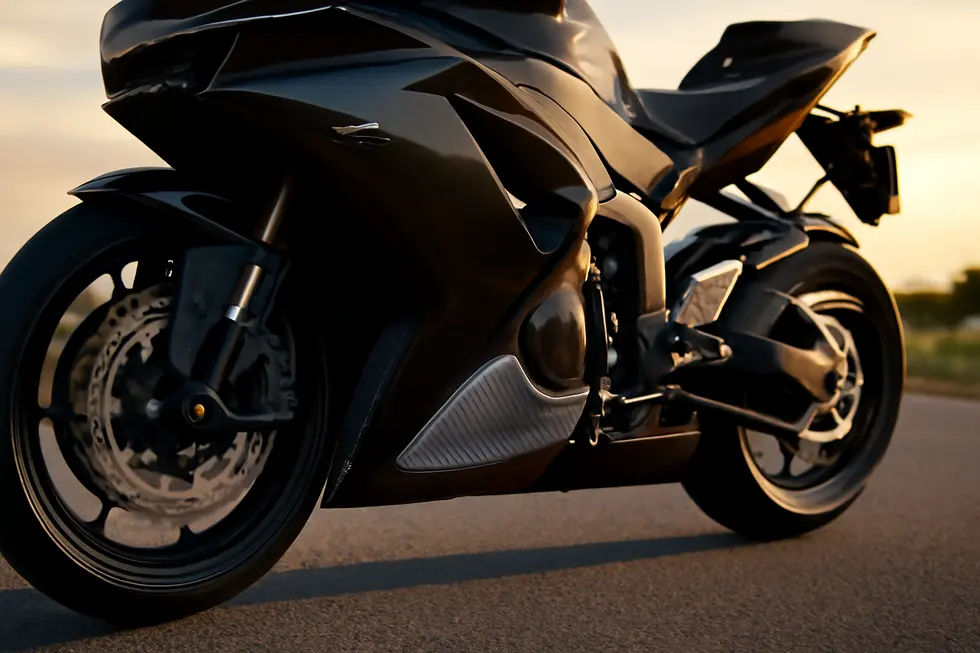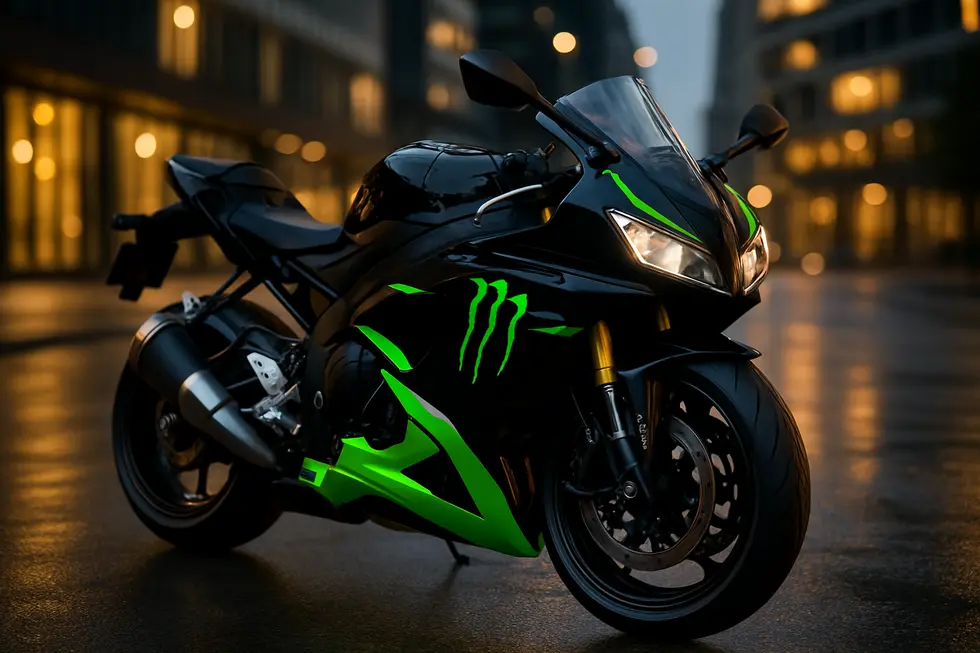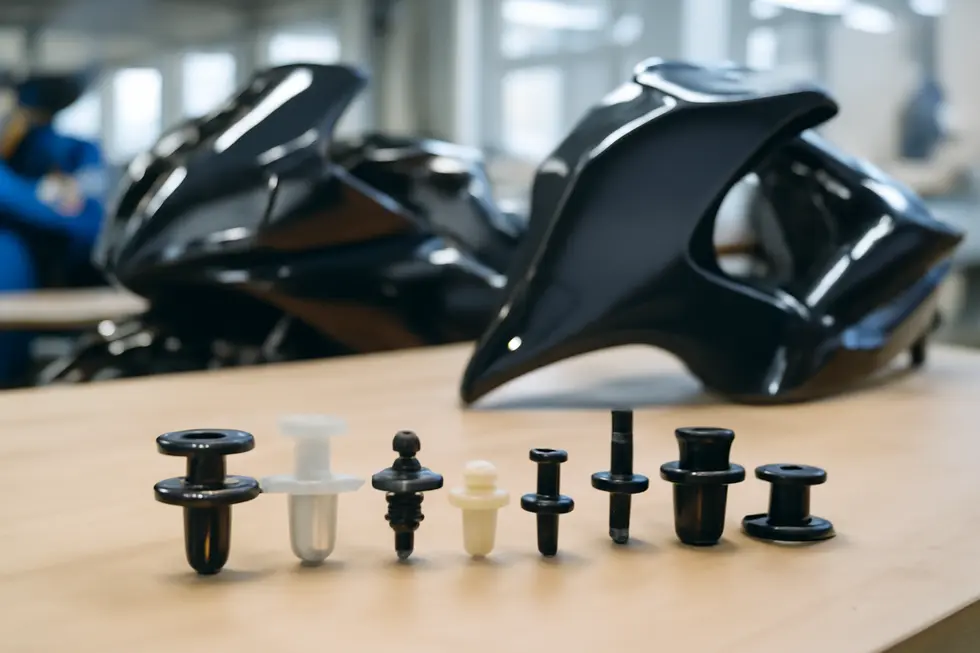Mastering Motorcycle Fairing Restoration: A Business Owner’s Guide to Precision and Profit
October 15, 2025 | by summitfairings
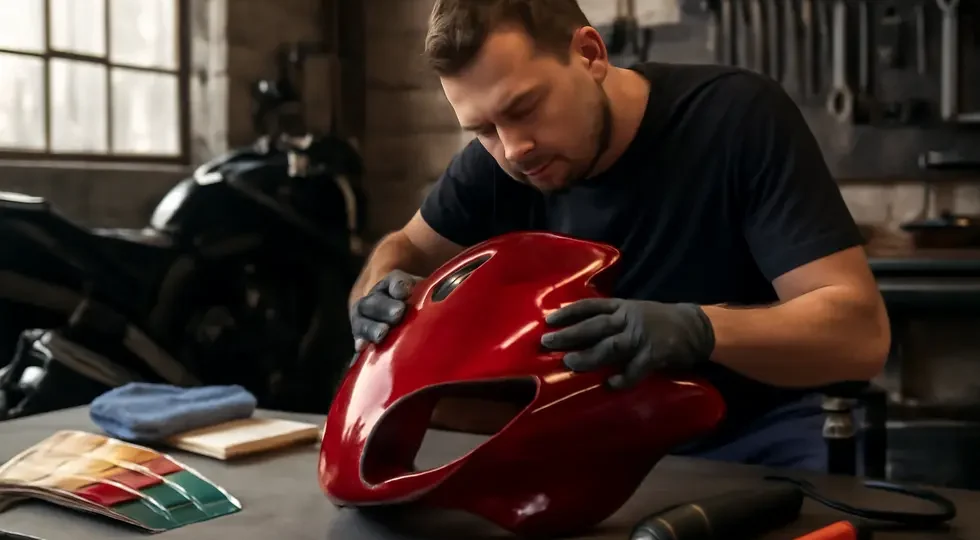
Introduction
Motorcycle fairing restoration is a critical service that enhances both the aesthetic appeal and structural integrity of bikes, presenting a unique business opportunity for shops seeking to expand or elevate their offerings. Understanding the meticulous steps involved—beginning with precise cleaning and surface preparation, progressing through advanced repair methods like plastic welding, and culminating in expert polishing and protective finishing—equips business owners to deliver high-quality results that build reputation and repeat clientele. Additionally, attention to authenticity and structural considerations ensures restorations meet the expectations of discerning riders and collectors, preserving value while ensuring safety. Each chapter unpacks these essential stages, providing actionable insights to seamlessly integrate comprehensive restoration services into your business model while maintaining efficiency and excellence.
Tables of Contents
Chapter 1: Essential Steps for Cleaning and Surface Preparation in Motorcycle Fairing Restoration
- Why Meticulous Cleaning Sets the Foundation for Successful Motorcycle Fairing Restoration
- Mastering Cleaning and Oxidation Removal for a Pristine Fairing Surface
- Mastering Sanding and Surface Refinement for a Flawless Fairing Base
- Achieving Brilliant Shine: Polishing and Protective Coatings for Motorcycle Fairings
- Effective Repair Strategies and Advanced Surface Treatment for Damaged Motorcycle Fairings
Chapter 2: Mastering Repair Techniques and Plastic Welding for Durable Motorcycle Fairing Restoration
- Fundamentals of Repair and Plastic Welding for Restoring Motorcycle Fairings
- Mastering Plastic Welding: Essential Techniques for Long-Lasting Motorcycle Fairing Repairs
- Optimal Surface Preparation and Cleaning: Foundations for Durable Repairs and Precise Plastic Welding
- Seamlessly Integrating Sanding, Painting, and Buffing with Plastic Welding for Flawless Motorcycle Fairing Repairs
- Balancing Temporary and Permanent Plastic Welding Solutions for Durable Fairing Repairs
Chapter 3: Mastering Finishing Techniques: Polishing and Protective Coatings in Motorcycle Fairing Restoration
- Essential Surface Preparation: The Foundation for Polishing and Protective Coatings on Motorcycle Fairings
- Mastering Advanced Sanding and Polishing Techniques for a Flawless Motorcycle Fairing Finish
- Mastering Polishing Techniques and Materials for a Flawless Motorcycle Fairing Finish
- Enhancing Durability and Shine: The Role of Protective Coatings in Motorcycle Fairing Restoration
- Mastering Professional Painting and Final Finishing for Lasting Motorcycle Fairing Shine
Chapter 4: Ensuring Authenticity and Structural Reliability in Motorcycle Fairing Restoration
- The Crucial Role of Material Authenticity in Preserving Fairing Strength and Durability
- Cutting-Edge Materials and Precision Techniques Enhancing Authenticity and Structural Integrity
- Balancing Costs and Value: Economic Impact of Preserving Authenticity and Strength in Fairing Restoration
- Geopolitical Influences on Authenticity and Structural Methods in Motorcycle Fairing Restoration
- The Influential Role of Community Standards in Preserving Authenticity and Strength in Fairing Restoration
Chapter 1: Essential Steps for Cleaning and Surface Preparation in Motorcycle Fairing Restoration
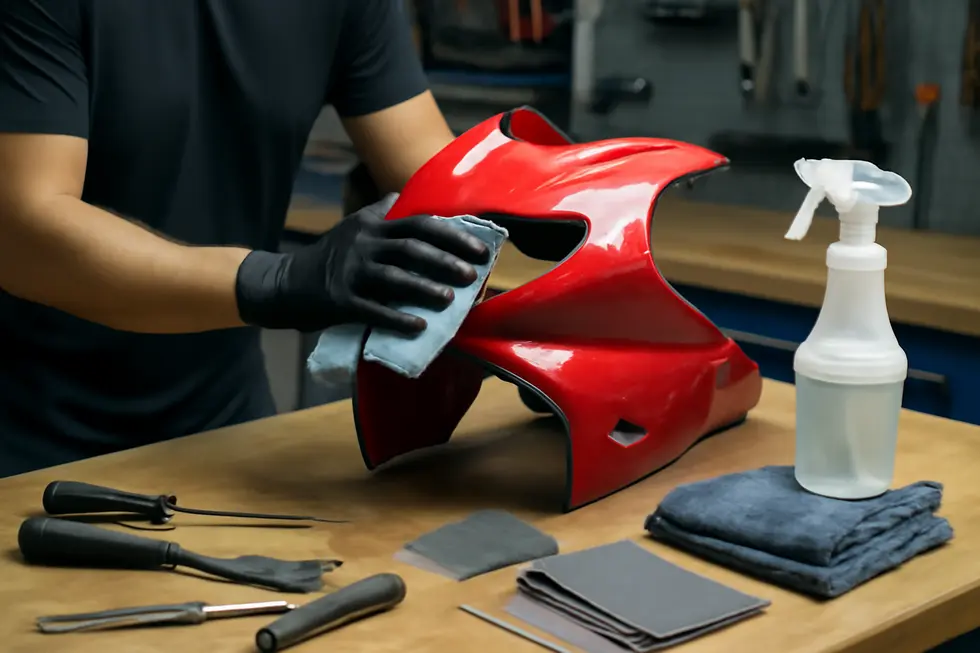
1. Why Meticulous Cleaning Sets the Foundation for Successful Motorcycle Fairing Restoration
Why Meticulous Cleaning Sets the Foundation for Successful Motorcycle Fairing Restoration
The restoration of motorcycle fairings begins with meticulous cleaning, a foundational step that profoundly impacts the quality of the entire project. Removing dirt, grease, and residual grime is vital as these contaminants can cause imperfections like swirl marks or dullness during polishing. Additionally, thorough cleaning ensures that sanding and painting processes achieve full adhesion, preventing peeling or uneven finishes later on. Beyond surface contaminants, residues left behind can embed into the plastic, turning minor scratches into stubborn blemishes. For metal components intertwined with fairings, eliminating rust and buildup is equally crucial to avoid structural weaknesses and ensure smooth refinishing. This cleaning stage uses gentle soaps and soft cloths to protect the fairing’s surface while effectively restoring its uniform appearance. By establishing a clean, contaminant-free base, subsequent steps such as oxidation removal, sanding, and polishing can be carried out with confidence, directly supporting a durable and visually compelling finish. For insights on preparation techniques, explore detailed resources that guide professional fairing care and surface prepping.
For practical tips and guidance on fairing preparation, see the extensive advice available at Explore the Best Motorcycle Fairings at Summit Fairings.
2. Mastering Cleaning and Oxidation Removal for a Pristine Fairing Surface
Restoring motorcycle fairings begins with meticulous cleaning to safeguard the plastic’s finish while removing dirt, grease, and contaminants. Using mild soap with soft cloths ensures effective cleansing without scratching or causing micro-abrasions. Following this, oxidation—a common issue leading to dull, faded surfaces—is carefully eliminated through wet sanding. Starting with sandpapers in the 1500 grit range and progressing up to 2000 grit, this process removes weathered layers evenly and refines surface imperfections. Crucially, the wet sanding method minimizes heat and friction buildup, preserving the plastic’s integrity.
Once sanding has smoothed the surface, gentle polishing with plastic-specific compounds restores clarity and shine without generating excessive heat, which could warp or melt the fairing. The final touch involves applying protective waxes or ceramic coatings formulated for motorcycles. These coatings shield against ultraviolet rays and environmental wear, prolonging gloss retention and enhancing durability. Avoiding harsh chemicals or abrasive tools throughout this process is vital to maintain the fairing’s original condition.
This systematic approach ensures the fairing is impeccably clean and ready for further refinishing, significantly boosting both appearance and longevity. For detailed guidance on these techniques, exploring comprehensive resources like the tutorials offered by Summit Fairings will prove invaluable.
3. Mastering Sanding and Surface Refinement for a Flawless Fairing Base
Successful motorcycle fairing restoration hinges on meticulous sanding and surface refinement following initial cleaning. After removing dirt and grease with mild soap and soft cloths, the fairings must be carefully wet sanded using fine-grit papers between 1500 and 2000 grit. This gradual abrasion smooths minor scratches and faded layers without compromising the plastic’s integrity. For deeper imperfections, applying touch-up paints and clear coats, then blending these repairs with fine sanding ensures seamless continuity. Thoroughly removing sanding residue is essential before moving on, as lingering dust or particles can disrupt polishing or clear coat adhesion. Maintaining a gentle, deliberate touch avoids warping or surface melting that harsh friction can cause. Once refined, the surface gains clarity and readiness for the next restorative phase, often polishing or coating application. This stage lays the foundation for a durable, high-gloss finish that resists environmental damage. For further insights on detailed buffing and surface care, explore comprehensive resources like the step-by-step guides available on Summit Fairings’ blog.
4. Achieving Brilliant Shine: Polishing and Protective Coatings for Motorcycle Fairings
After careful cleaning and sanding, polishing breathes life back into motorcycle fairings by restoring their clarity and gloss. Using a dedicated plastic polish or gentle rubbing compound applied with a soft cloth or low-speed buffer ensures the surface regains its original shine without overheating. Excessive speed or pressure during buffing can warp or melt plastic, so patience and gentle circular motions across small sections produce the best results. Polishing not only improves aesthetics but also refines the surface to accept protective coatings more effectively.
Applying these protective layers is essential for long-term preservation. Waxes or ceramic coatings form a shield against UV rays, dirt, and environmental contaminants, helping to maintain the vibrant look achieved through restoration. These coatings enhance gloss retention and offer durable defense against everyday wear. Proper application techniques, such as applying thin, even layers and allowing adequate curing time, maximize their effectiveness. This final step ensures the fairings stay radiant and resilient, complementing the thorough cleaning and surface refinement stages that precede it.
For insights on mastering polishing and finishing, see detailed guidance available at Summit Fairings’ expert resources on buffing motorcycle fairings.
5. Effective Repair Strategies and Advanced Surface Treatment for Damaged Motorcycle Fairings
Restoring motorcycle fairings begins with meticulous cleaning to remove dirt and grease without harming the plastic finish, using mild soaps and soft cloths. Once clean and dry, surfaces exhibiting oxidation or fading benefit from careful wet sanding with progressively finer grits (1500 to 2000), which removes dull, weathered layers and smooths imperfections. Addressing physical damage typically involves plastic welding, a technique that reunites cracked or broken sections with durable bonds far superior to conventional adhesives. Following structural repairs, applying touch-up paint and clear coats, then fine sanding, blends repairs seamlessly for a factory-quality appearance. Polishing with specialized plastic compounds revives clarity and gloss, but care is essential to avoid overheating or warping during buffing. The restoration concludes with protective coatings—waxes or ceramic treatments—that shield surfaces from UV damage and environmental wear, significantly enhancing longevity and shine. Additionally, specialty products can remove minor marks without sanding, while full refinishing may require professional multi-step paint application. For comprehensive guidance on sanding, polishing, and refinishing, detailed visual tutorials offer invaluable support to achieve a pristine, durable finish in fairing restoration.
Chapter 2: Mastering Repair Techniques and Plastic Welding for Durable Motorcycle Fairing Restoration
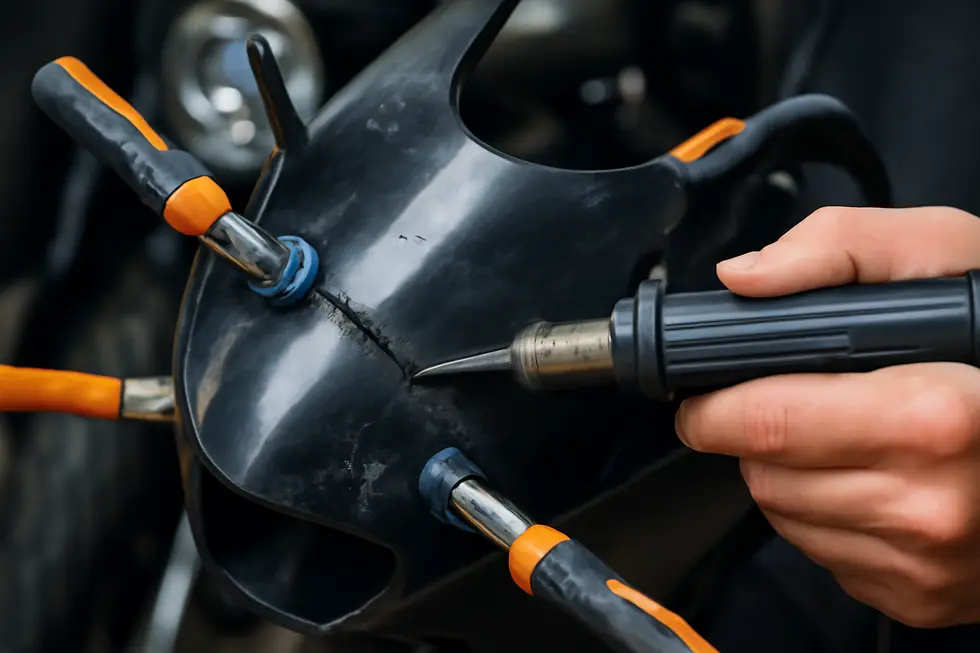
1. Fundamentals of Repair and Plastic Welding for Restoring Motorcycle Fairings
Restoring motorcycle fairings demands a blend of skillful repair techniques and precise plastic welding to ensure both cosmetic and structural integrity. Effective restoration starts by addressing surface imperfections such as scratches and fading through careful sanding and polishing. When fairings suffer cracks or breaks, plastic welding stands out as the most reliable solution, fusing damaged plastic parts seamlessly and restoring their original strength. Unlike adhesives, this method creates a lasting, durable bond that withstands stress and weather exposure. Complementary repairs like touch-up painting and clear coating help blend damaged areas with the surrounding surface, maintaining factory-level finish and appearance. Additionally, securing loose or misaligned components by replacing or adjusting fasteners ensures proper fitment. This holistic approach, combining plastic welding with detailed refinishing techniques, provides a comprehensive restoration framework. For further insights on achieving optimal surface polishing and buffing, explore detailed practical guidance available on specialized motorcycle fairing resources.
2. Mastering Plastic Welding: Essential Techniques for Long-Lasting Motorcycle Fairing Repairs
Plastic welding stands as a premier repair method for motorcycle fairings, offering a durable and resilient solution that restores both form and function. By melting and fusing plastic edges or filler materials with a heated tool, this technique creates bonds far stronger than adhesives, ensuring the repaired area withstands vibrations, weather, and heat encountered during riding. Common fairing plastics like ABS and polypropylene respond effectively to welding when surfaces are properly cleaned and burrs removed beforehand. Incorporating reinforcements such as cotton fibers within melted plastic can further enhance strength for cracks or holes. Precise temperature control is critical to avoid damage like warping, while step-by-step demonstrations and tutorials can guide both enthusiasts and professionals through filling, smoothing, and blending repaired sections to near-original aesthetics. This cost-effective process extends the life of damaged fairings without the expense of replacement and demands meticulous care to achieve seamless results. For a practical resource on techniques tailored to motorcycle fairings, readers may explore detailed insights on buffing and finishing at Summit Fairings’ blog.
3. Optimal Surface Preparation and Cleaning: Foundations for Durable Repairs and Precise Plastic Welding
Effective motorcycle fairing restoration hinges on meticulous surface preparation and cleaning, which lay the groundwork for all subsequent repair techniques, including plastic welding. Before any bonding or welding can occur, the fairing’s surface must be free from dirt, grease, oils, and residual contaminants. Using isopropyl alcohol with microfiber cloths ensures a thorough cleanse without damaging the plastic’s finish, promoting superior adhesion of primers and repair materials. Equally vital is sanding or scuffing the damaged areas to create a textured surface that enhances mechanical adhesion, allowing welding rods or adhesives to fuse seamlessly with the original plastic. After sanding, removing all dust and debris is essential to prevent weak spots or finish imperfections. These preparation steps not only strengthen plastic welds but also prepare the surface for primer application, which smooths imperfections and guarantees lasting paint adhesion. Neglecting this careful preparation risks compromised repairs and poor finish quality, underscoring its importance in achieving both durable structural restoration and an authentic factory-level appearance. For practical guidance on these techniques, consult comprehensive tutorials on motorcycle fairing painting and restoration found on Summit Fairings’ blog.
4. Seamlessly Integrating Sanding, Painting, and Buffing with Plastic Welding for Flawless Motorcycle Fairing Repairs
Successful motorcycle fairing restoration hinges on the precise integration of plastic welding with complementary surface finishing techniques. Plastic welding addresses structural damage by fusing cracked or broken sections to restore original strength. Following this foundational repair, carefully executed sanding removes weld seams and levels the surface using progressively finer grits—typically from 400 up to 2000 grit—to prepare for refinishing. This wet sanding process prevents heat buildup and creates a smooth base essential for paint adhesion. Next, painting refurbishes the fairing’s color, applying plastic-specific primers and multiple thin coats of base color matched precisely to the original scheme. A clear coat seals the surface, providing gloss and UV protection. Finally, buffing with gentle pressure and fine polishing compounds eliminates minor surface irregularities, restoring a showroom-quality shine without warping the plastic. Each step builds on the previous for a repair that is both structurally sound and visually indistinguishable from the factory finish. This holistic approach ensures that restored fairings can withstand use while maintaining authentic aesthetics. Further insights on buffing techniques can be explored in this detailed guide.
5. Balancing Temporary and Permanent Plastic Welding Solutions for Durable Fairing Repairs
Balancing Temporary and Permanent Plastic Welding Solutions for Durable Fairing Repairs
Effectively restoring motorcycle fairings requires selecting the appropriate repair strategy, where plastic welding serves as a pivotal method for both temporary and permanent fixes. Temporary repairs prioritize quick restoration of structural integrity, often employing plastic welding kits to melt staples directly into cracked fairings. This approach offers immediate strength superior to adhesives and allows riders to safely continue using their motorcycles until comprehensive repairs are feasible. However, these quick patches focus on function over flawless aesthetics and generally lack finishing refinements.
In contrast, permanent repairs demand meticulous part alignment and complete fusion of the plastic at break points, creating molecular bonds nearly equal in strength to the original material. Reinforcements with extra staples or fillers further enhance durability and resistance to vibration. Post-welding sanding and painting seamlessly restore the fairing’s original appearance and protect the repair against environmental wear. Employing composite fillers alongside plastic welding in high-stress areas can significantly extend repair longevity.
The fused bond plastic welding offers is indispensable for motorcycle fairings, where stresses from vibration and impacts challenge weaker glued repairs. Choosing between temporary and permanent plastic welding hinges on the urgency, desired durability, and finish quality. For hands-on guidance tailored to motorcycle fairings, exploring dedicated resources can deepen understanding of welding nuances crucial for lasting restoration. For more insights, visit explore the best motorcycle fairings.
Chapter 3: Mastering Finishing Techniques: Polishing and Protective Coatings in Motorcycle Fairing Restoration
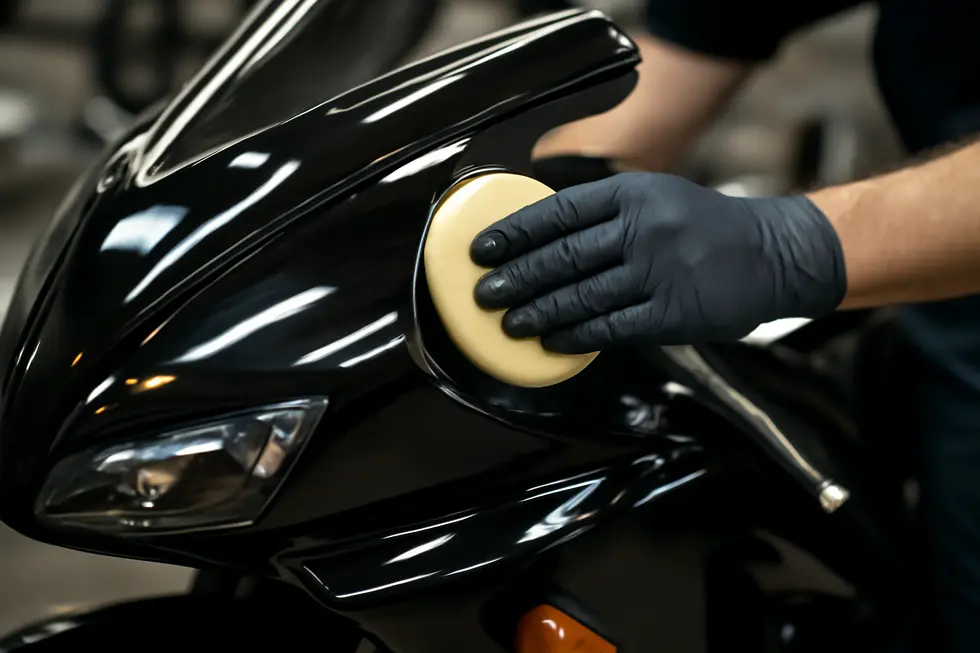
1. Essential Surface Preparation: The Foundation for Polishing and Protective Coatings on Motorcycle Fairings
Surface preparation is the crucial first step that influences the success of polishing and protective coating applications during motorcycle fairing restoration. Proper cleaning removes dirt, grease, and contaminants using mild soap and soft cloths to avoid damaging paint or plastic surfaces. For metallic or painted components, more intensive measures such as professional sandblasting strip away rust, old coatings, and oxidation, revealing a clean base ideal for refinishing. Wet sanding with fine grit sandpapers between 1500 and 2000 grit refines plastic fairings by smoothing minor scratches and faded patches, ensuring a uniform texture ready for polishing. Removing all sanding residues is vital to prevent adhesion issues or surface imperfections. Polishing then restores gloss and clarity through gentle application of plastic-friendly compounds, avoiding excessive heat or abrasive chemicals that can warp or dull the surface. Finally, the application of protective treatments like waxes or advanced ceramic coatings locks in the finish, offering UV resistance and enhanced durability against environmental wear. This methodical progression from careful cleaning to sealing guarantees lasting, high-quality restoration results. For insights on refinishing techniques and surface preparation, exploring specialized motorcycle fairing resources can provide valuable guidance.
2. Mastering Advanced Sanding and Polishing Techniques for a Flawless Motorcycle Fairing Finish
Achieving a flawless finish on motorcycle fairings requires meticulous sanding and polishing techniques tailored to plastic surfaces. After thorough cleaning removes surface contaminants, wet sanding with progressively finer grit sandpapers—usually between 1500 and 2000 grit—smooths oxidation, fading, and minor scratches. This gradual refinement prepares the surface for polishing without compromising the plastic’s integrity. Polishing follows with specialized fine compounds and soft pads, applying light, overlapping circular motions to avoid heat buildup that could warp or melt the fairing. For deeper imperfections, carefully applied touch-up paint and clear coats, blended with additional fine sanding, restore uniformity and color depth. The process culminates with protective waxes or ceramic coatings, which guard against ultraviolet exposure and environmental wear while enhancing gloss and durability. When structural defects exist, plastic welding prior to finishing reinforces the fairing’s strength without sacrificing appearance. This comprehensive approach, practiced with patience and precision, revitalizes fairings to a rich, factory-quality shine that endures. For practical insights and stepwise guidance, enthusiasts can explore detailed resources like the Summit Fairings buffing and sanding tutorials.
3. Mastering Polishing Techniques and Materials for a Flawless Motorcycle Fairing Finish
Polishing motorcycle fairings demands a nuanced approach tailored to their specific materials, such as ABS plastic, fiberglass, or carbon fiber. Selecting polishes designed for these substrates is critical to avoid chemical damage or discoloration—testing in a discreet spot is always recommended. A progressive polishing routine begins with a cutting compound to remove oxidation and surface scratches, followed by a medium polish to eliminate haze and refine texture, and concludes with a fine finishing polish that enriches gloss and clarity. Employing soft polishing pads with consistent, overlapping motions minimizes heat buildup, protecting plastic fairings from warping. After polishing, thorough cleaning with isopropyl alcohol ensures removal of residue, enabling protective coatings like waxes or clear sealants to bond effectively. These coatings safeguard the restored finish from UV damage and environmental wear, prolonging gloss retention. This carefully staged polishing and protection process is essential for achieving a vibrant, durable finish that revitalizes the motorcycle’s aesthetic and maintains structural integrity. For further insights and stepwise guidance, consult detailed restoration resources such as those offered by Summit Fairings.
4. Enhancing Durability and Shine: The Role of Protective Coatings in Motorcycle Fairing Restoration
Protective coatings are a vital final step in motorcycle fairing restoration, sealing in the polish and shielding the surface from the elements. After careful sanding and polishing, applying a layer of wax, sealant, or advanced ceramic coating creates a resilient barrier against UV rays, oxidation, dirt, and moisture. This barrier not only preserves the fairing’s restored gloss and color vibrancy but also simplifies routine cleaning by repelling grime and contaminants. While waxes offer a traditional protective finish with ease of application, ceramic coatings provide long-lasting durability and resistance to water spots and environmental damage, extending the fairing’s lifespan significantly. Combined with paint protection films, these coatings can guard against scratches and minor impacts, crucial for maintaining aesthetic and structural quality over time. Employing protective coatings reduces the need for frequent refinishing, saving both time and expense, and helps retain the motorcycle’s value and visual appeal. For deeper insight into maintaining flawless fairings and finishing techniques, explore detailed resources available through summit fairings’ expert guidance.
5. Mastering Professional Painting and Final Finishing for Lasting Motorcycle Fairing Shine
Achieving a flawless finish in motorcycle fairing restoration hinges on meticulous professional painting and refined final finishing techniques. The process starts with careful surface preparation—cleaning and sanding remove imperfections, ensuring optimal paint adhesion. A multi-layer paint application follows, including primer, base, color, and top coats, each contributing to durability and color fidelity while protecting against environmental wear. Once painted, applying a clear coat seals and enhances the vividness of the color, offering critical resistance to UV rays and abrasion. Polishing with specialized compounds restores the fairing’s glossy clarity by eliminating fine scratches and swirl marks, bringing out a deep, glass-like shine. The final touch involves protective coatings such as motorcycle-safe waxes or ceramic treatments that lock in the finish, extending gloss retention and shielding against fading and contaminants. This comprehensive approach demands precision and patience but rewards restored fairings with a professional, showroom-quality appearance that endures. For deeper insights on fairing refinishing, explore expert restoration guides such as those provided by Summit Fairings.
Chapter 4: Ensuring Authenticity and Structural Reliability in Motorcycle Fairing Restoration
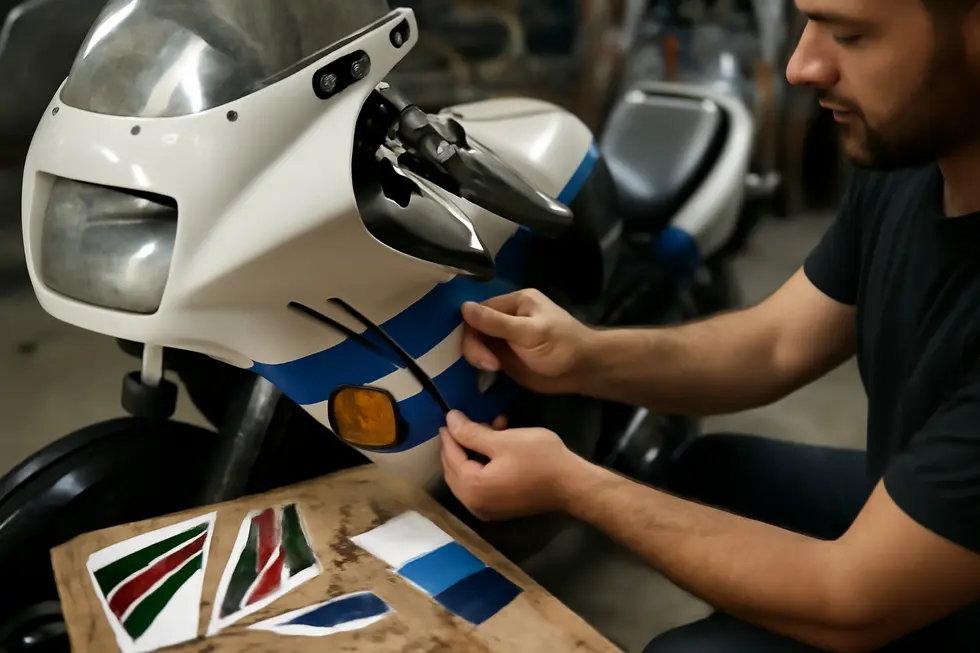
1. The Crucial Role of Material Authenticity in Preserving Fairing Strength and Durability
Motorcycle fairings are engineered to balance aesthetics with resilience, making material authenticity essential in restoration. Using original or equivalent materials ensures the fairing withstands impacts, resists chemical exposure, and endures thermal and UV stresses without compromising safety or longevity. Substituting with inferior plastics lacking proper reinforcement or additives can lead to brittleness, premature cracking, and warping, undermining both structural integrity and visual accuracy. Fitment precision, influenced by authentic material thickness and flexibility, affects aerodynamics and attachment point stress, which in turn impacts handling and durability. Where original parts are unavailable, restorers must seek certified replacements matching OEM mechanical and chemical properties to maintain safety and performance standards. Choosing materials compliant with international quality benchmarks supports consistent strength and resistance to environmental wear, enhancing the fairing’s lifespan. This commitment to authentic, high-grade materials ultimately preserves the motorcycle’s original character while ensuring reliable protection and performance over time. For practical insights on sourcing and maintaining quality fairings, see this detailed resource on motorcycle fairings.
2. Cutting-Edge Materials and Precision Techniques Enhancing Authenticity and Structural Integrity
The restoration of motorcycle fairings today is deeply influenced by advances in materials science and precision technologies, which ensure authentic replication while reinforcing structural durability. Modern composite materials like carbon fiber and advanced polycarbonates offer exceptional strength-to-weight ratios, allowing restorers to maintain original contours without excessive mass. Precision tools such as 3D scanning and CAD enable faithful reproduction of even complex shapes, preserving the precise fit and aerodynamic properties integral to the fairing’s design. These technologies also facilitate internal structural reinforcements without altering the visible appearance. Additionally, contemporary aerodynamic insights guide subtle refinements during restoration to meet evolving regulatory and performance standards, balancing authenticity with functional improvements. Integrating modern electronics and cooling systems within fairings requires careful planning to avoid compromising original designs while accommodating new components. Together, these innovations empower restorers to achieve a high-fidelity finish that respects the motorcycle’s heritage and enhances longevity. For those interested in exploring the impact of such advancements, resources delving into material choices and structural design offer valuable perspectives on achieving excellence in motorcycle fairing restoration. For further insights, see the detailed discussions available at Explore the Best Motorcycle Fairings at Summit Fairings.
3. Balancing Costs and Value: Economic Impact of Preserving Authenticity and Strength in Fairing Restoration
Restoring motorcycle fairings to their original condition requires carefully balancing economic factors with the pursuit of authenticity and structural integrity. Repairing original plastic fairings through methods like plastic welding usually costs less than sourcing expensive replacements, particularly for rare or vintage models. This cost-effectiveness helps owners maintain the motorcycle’s authentic appearance, a critical factor that boosts resale value and appeal to collectors. Yet, prioritizing structural soundness is equally vital because cracks or poorly executed repairs undermine safety and may lead to costly accidents or repeated damage. Beyond fairings, restoration projects often entail hidden expenses such as brake components or tires, emphasizing the importance of diligent budgeting. Investing in quality repairs preserves both aesthetic authenticity and functional durability, ultimately protecting the bike’s market value while mitigating safety risks. For those seeking guidance on affordable and authentic restoration parts, exploring expert resources like the Summit Fairings blog can provide valuable insights tailored to comprehensive motorcycle restoration needs.
4. Geopolitical Influences on Authenticity and Structural Methods in Motorcycle Fairing Restoration
Geopolitical factors deeply shape the standards of authenticity and structural techniques in motorcycle fairing restoration. Trade restrictions, embargoes, and sanctions often disrupt the supply of original parts, compelling restorers to rely on replicas or custom fabrications that might not fully match factory specifications. Variations in intellectual property enforcement further complicate sourcing, as counterfeit parts proliferate in regions with lax regulations while stringent policies may hinder legitimate imports. Cultural perspectives also affect priorities, with some areas favoring functional repairs over historical precision due to economic realities.
These dynamics extend to structural practices, where access to advanced materials like specific composites or resins is controlled by export regulations or environmental policies. Skilled artisanship, crucial for accurate restoration, is uneven globally, impacted by political and economic shifts that affect workforce availability. Technological infrastructure disparities influence restoration quality, ranging from equipment to controlled environments. Economic factors further dictate whether labor-intensive traditional methods or faster industrial processes prevail.
Such geopolitical complexities urge restorers to adapt creatively while balancing authenticity and practicality. For deeper insights on sourcing and restoration challenges, exploring community discussions offers valuable perspectives that inform this nuanced craft.
5. The Influential Role of Community Standards in Preserving Authenticity and Strength in Fairing Restoration
Motorcycle fairing restoration is deeply influenced by the collective values and expectations of enthusiasts and collectors. These communities prioritize maintaining a motorcycle’s original identity, valuing period-accurate materials, techniques, and finishes that honor the bike’s heritage. This commitment to authenticity extends beyond mere appearance, encompassing functional integrity that ensures the fairings remain secure and safe. Restorers must carefully navigate the balance between preserving historical accuracy and reinforcing structural soundness, mindful of the societal emphasis on reliable, safe riding experiences. Knowledge sharing within forums and clubs strengthens these standards, fostering detailed guidance on aligning repairs with original specifications. Such social dynamics create a strong expectation not only for aesthetic fidelity but for durable, well-executed restoration work that respects the motorcycle’s legacy. This community-driven vigilance supports restorers in achieving both visual and functional excellence, ensuring each restoration upholds the motorcycle’s true character and safety. For insights on maintaining fairing quality throughout restoration, explore expert guidance at Summit Fairings’ blog.
Final thoughts
Restoring motorcycle fairings is an art that requires precision, skill, and a comprehensive understanding of each stage—from initial cleaning to final authenticity checks. For business owners, mastering this craft not only improves the quality and durability of restored parts but also enhances customer trust and profitability. Each phase is interdependent, where meticulous surface preparation leads to effective repairs, polished finishes boost visual appeal, and authentic restoration practices uphold the bike’s value and structural safety. By integrating these specialized techniques into your service portfolio, your business can stand out in a competitive market, delivering outstanding results that satisfy both casual riders and passionate collectors alike.
Ready to elevate your ride? Summit Fairings delivers premium, custom-fit fairings that blend style and durability. Whether you’re chasing speed or turning heads, we’ve got your bike covered. Don’t wait—transform your machine today. Click, customize, and ride with confidence. Your perfect fairing is just a few clicks away. Act now!
About us
undefined
RELATED POSTS
View all

